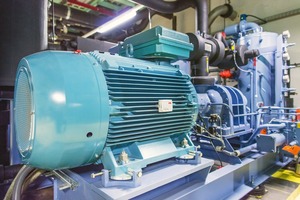

|
Edward Lowton
Editor |


|
| Home> | Plant, Process & Control | >Motors and drives | >Electric motors achieve IE5 energy efficiency without rare earth magnets |
Electric motors achieve IE5 energy efficiency without rare earth magnets
29 July 2020
Tero Helpio, Global Product Manager, IEC LV motors, ABB Motion, explains how upgrading to IE5 ultra-premium SynRM motors can help industrial operators to cut their energy losses by up to 50 percent compared to IE2 motors

The Increasing global emphasis on energy efficiency is prompting manufacturers and operators of industrial equipment to seek new solutions to reduce their energy consumption. Often the most cost-effective approach is to use high efficiency low voltage (LV) electric motors combined with speed control in the form of variable speed drives (VSDs). It was against this background that ABB launched its magnet-free IE4 synchronous reluctance (SynRM) motor technology in 2011 – IE4 refers to the energy efficiency class defined by the International Electrotechnical Commission (IEC).
The SynRM concept has proved very successful, with a number of case studies in industrial installations demonstrating energy savings of up to 25 percent, depending on the application. That was however just the start. Because some industry segments are already demanding energy efficiency levels beyond IE4.
ABB’s response has been to extend the SynRM technology platform to the IE5 ultra-premium efficiency class. This step up from IE4 to the IE5 class represents a further 20 percent reduction in motor losses. In addition, the IE5 SynRM motors offer up to 50 percent lower energy losses and significantly lower energy consumption than the commonly used IE2 induction motors
Specialised rotor design
The key to the SynRM platform is the specialised rotor design based on well-established technology. To understand why this makes an important difference, it is useful to consider the rotor losses in conventional induction motors. These motors have a squirrel cage rotor in which currents are induced in the bars. The end rings form a short circuit allowing heavy currents to flow. This causes heating, and the resulting losses can amount to around 40 percent of the motor’s overall energy losses.
In contrast, the SynRM motor has no squirrel cage, so no currents flow in the motor. There are therefore no rotor losses. Furthermore, the SynRM motor does not feature magnets or rare earth materials, ensuring an environmentally-friendly design.
The SynRM motor works on the basis of a magnetic flux created by the stator and controlled by the VSD. The rotor tries to align itself relative to the stator flux. The VSD causes the flux to rotate and this pulls the rotor around with it, creating torque. The VSD monitors the rotor’s position to ensure it stays synchronized. The importance of the VSD means that IE5 SynRM motors should always be specified as part of a complete motor and drive package.
The low energy losses mean that IE5 SynRM motors run cooler than induction motors. A reduction in temperature of just 10°C can enable the windings to last twice as long. While a 15°C decrease in running temperature doubles the lifetime of the bearing lubrication. The design also creates less motor noise for a better working environment. And when the time comes for maintenance the magnet-free rotor enables easy servicing.
The IE5 SynRM motors can be used in a wide range of demanding industrial applications where they offer accurate control and high efficiency across the whole speed range, even at partial loads. This makes them an ideal upgrade option for standard induction motors in pumps, fans and compressors as well as in more demanding applications like extruders, concha mixers, winches, and conveyors. IE5 SynRM motors are an easy replacement for induction motors as they have the same size and output power, so no mechanical modifications are required.
Currently, the IE5 SynRM motors are available with output power of 5.5 to 315 kilowatt (kW) in frame sizes IEC 132-315.
For further information: https://bit.ly/3hNcuaF
- 'Maintaining the status quo' approach no longer fit for purpose
- ABB Robotics to preview SCARA at the PPMA Total Show 2016
- ABB's ProKiln probe helps increase safety
- Unlocking data for smarter chemical plant operations
- Multi-million pound Energy Centre officially opens
- ABB and Tata Steel UK expand partnership at Port Talbot
- Bringing AI to asset performance management
- ABB automation technology to modernise and future-proof ENGIE power plant
- Intelligent energy monitoring expanded
- Breaking new ground for circuit breakers


















